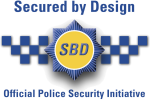Key safes
A key safe is a strong mechanical metal box in which you can securely stores the key to your door. It is installed into brick or concrete on the outside of your property and your keys are accessed by a combination code.
The combination code will only be known to you and anyone with access to your property. It allows your door key to be retrieved so your property can be entered quickly in an emergency.
Essex Police recommend key safes that have a 'Secured by Design' approval. When buying a key safe you should make sure it has the 'Secured by Design' approval and logo.

A key safe is only secure if it has been fitted correctly.
You should follow the manufacturer's instructions exactly to make sure your key safe is fitted securely to a solid surface such as brickwork or concrete using the approved fittings.
Best locations for a key safe
A key safe should be hidden out of site to reduce the risk of the property being targeted by burglars. You should ask yourself whether it:
- can be seen from the road
- is at eye level
- is easily identifiable as a key safe
- is near the door
If your answer is "yes" to any of these, you should consider moving the safe somewhere else. It should be fitted in a position where:
- it cannot be seen by passers-by - for example, it could be hidden by a window box, mailbox, drainpipe or plants
- anyone tampering with it is clearly visible
Remember the safe contains a key to your home, keep this out of sight as much as possible
Changing the code
Essex Police recommend you regularly change the code for your key safe.
All key safes are supplied un-coded, and you set the code yourself. It's as easy to change the code as it is to set it for the first time. The code can be changed as many times as you wish – contact the manufacturer if you need help.
How to open a key safe
To open a key safe:
- before attempting to set the code, press the CLEAR button – the key safe is now ready for you to enter the code
- when entering the code it is important that each button clicks when it is pressed
- once the code has been successfully entered, remove the lid by simply pressing the OPEN button down
- if for any reason the OPEN button will not move down as you press it, repeat the points above
How to close a key safe
To close a key safe:
- with the lid in your hand repeat the first 2 points above
- once the code has been successfully entered offer the bottom of the lid to the vault, making sure the key is not blocking the lid
- once the bottom of the lid is correctly located into the bottom of the vault, press and hold the OPEN button down and push the lid into the vault
- once you are happy the lid is flush with the vault, release the OPEN button and it will return to its highest position - all you need to do now is remember to replace the cover.
Preventing break-ins
If someone finds the key safe and tries to get into it, there are 2 ways of opening the box:
- by entering the code
- by knocking the box off the wall and smashing it to pieces
Before anyone can try cracking the code they need to know how many digits it has. Most codes we use have 4 digits, eg cash point cards, TV PINs. We suggest using a 5 or 6 digit code is used for your key safe.
Smashing the box would be both noisy and time consuming, a need tools such as a large hammer and chisel. An opportunist thief is much more likely to shoulder a door or break a window than break into a key safe.
Key safes and contents insurance
When KeySafe was introduced into the UK, the distributor approached Lloyd's of London - who underwrite a large proportion of insurance business in the UK - to ask their opinion. Lloyd's said that there must be evidence of forced entry for any successful claim on a contents insurance policy. At the time of asking, Lloyd's could not answer whether or not breaking into the KeySafe would constitute forced entry.
